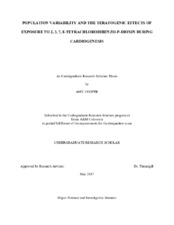| dc.creator | Cooper, Amy | |
| dc.date.accessioned | 2017-10-10T20:29:12Z | |
| dc.date.available | 2017-10-10T20:29:12Z | |
| dc.date.created | 2017-05 | |
| dc.date.submitted | May 2017 | |
| dc.identifier.uri | https://hdl.handle.net/1969.1/164541 | |
| dc.description.abstract | 2, 3, 7, 8-tetrachlorodibenzo-p-dioxin, also known as dioxin, is a powerful, environmental teratogen that researchers have failed to properly assess. Current maternal exposure studies do not consider genetic background as a factor in response variation. We aim to incorporate genetic variability found within the population in assessing exposure risks to dioxin during pregnancy. We will focus particularly on cardiogenesis by investigating early expression of cardiogenic markers. By using 5 different strains of pregnant female mice, we will mimic individual genetic types found in the human population. Over a 10-day period, pregnant mice will be exposed to different doses of TCDD (0, 1, 100 ng/kg). The embryos will then be removed and the heart excised to analyze the molecular and histological changes in development. Ultimately, the results of this study will elucidate the importance of including population heterogeneity in assessing toxicant exposure risks during cardiac development and potentially aiding in the underlying mechanism and treatment. | en |
| dc.format.mimetype | application/pdf | |
| dc.subject | dioxin, cardiogenesis, population variability | en |
| dc.title | Population Variability and the Teratogenic Effects of Exposure to 2, 3, 7, 8-tetrachlorodibenzo-p-dioxin during Cardiogenesis | en |
| dc.type | Thesis | en |
| thesis.degree.department | Entomology | en |
| thesis.degree.discipline | Forensic & Investigative Sciences | en |
| thesis.degree.grantor | Undergraduate Research Scholars Program | en |
| thesis.degree.name | BS | en |
| thesis.degree.level | Undergraduate | en |
| dc.contributor.committeeMember | Threadgill, David W | |
| dc.type.material | text | en |
| dc.date.updated | 2017-10-10T20:29:12Z | |


